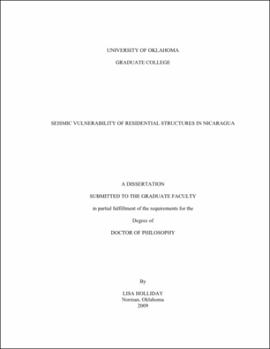| dc.contributor.advisor | Mish, Kyran | |
| dc.creator | Holliday, Lisa M. | |
| dc.date.accessioned | 2019-04-27T21:21:13Z | |
| dc.date.available | 2019-04-27T21:21:13Z | |
| dc.date.issued | 2009 | |
| dc.identifier | 99118820002042 | |
| dc.identifier.uri | https://hdl.handle.net/11244/318472 | |
| dc.description.abstract | In recent times, many parts of the world have seen a trend of increased construction with reinforced concrete and masonry block systems. These systems can provide excellent seismic resistance when they are designed by an engineer, built by well-trained workers, constructed of quality materials and all in conformance with building codes. Unfortunately, many structures are constructed without one or more of these requirements. Property owners are building multi-story buildings while paying little attention to building codes or seismic resistance. Adding to the problem, reinforced concrete and masonry block systems enable construction with longer spans, larger openings, and irregular shapes; all of which reduce the earthquake resistance of a building. Such buildings are deceptive because they appear safe, perform well under gravity loads and do not sag or lean. Such buildings are also heavy which adds to the illusion of safety. There is often no consideration given to lateral loads - exactly the type of loads experienced during an earthquake. When an earthquake occurs, it creates a fast cyclic lateral load. The weight of the building increases the lateral loads created by an earthquake, which when lacking sufficient design, results in collapse. | |
| dc.description.abstract | Designing structures to withstand the impact of a major catastrophe is a daunting task under the best of circumstances. For developing countries, this task is nearly impossible. This research evaluates the structural systems of existing buildings in Nicaragua, sampling buildings made from both engineered and earthen materials, and makes recommendations for low-cost enhancements that will improve their structural integrity. | |
| dc.format.extent | 273 pages | |
| dc.format.medium | application.pdf | |
| dc.language | en_US | |
| dc.relation.requires | Adobe Acrobat Reader | |
| dc.subject | Earthquake resistant design--Nicaragua | |
| dc.subject | Earthquake engineering--Nicaragua | |
| dc.subject | Earthquakes--Nicaragua | |
| dc.title | Seismic Vulnerability of Residential Structures in Nicaragua | |
| dc.type | text | |
| dc.type | document | |
| dc.thesis.degree | Ph.D. | |
| ou.group | College of Engineering::School of Civil Engineering and Environmental Science | |
